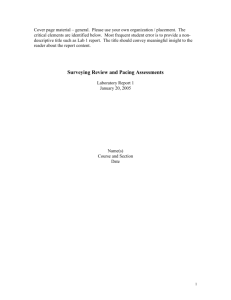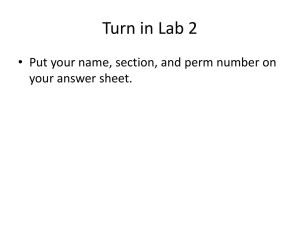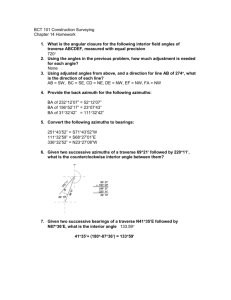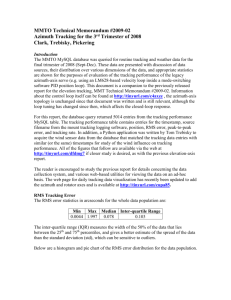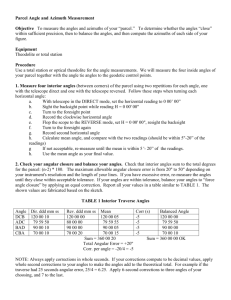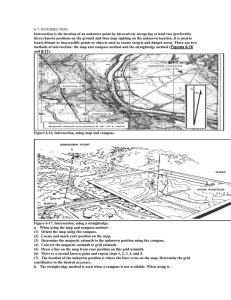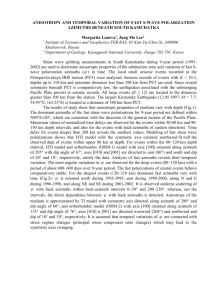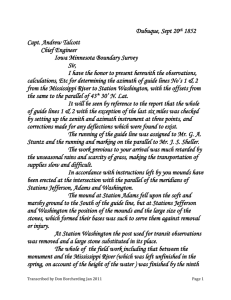measurement of directions and angles
advertisement
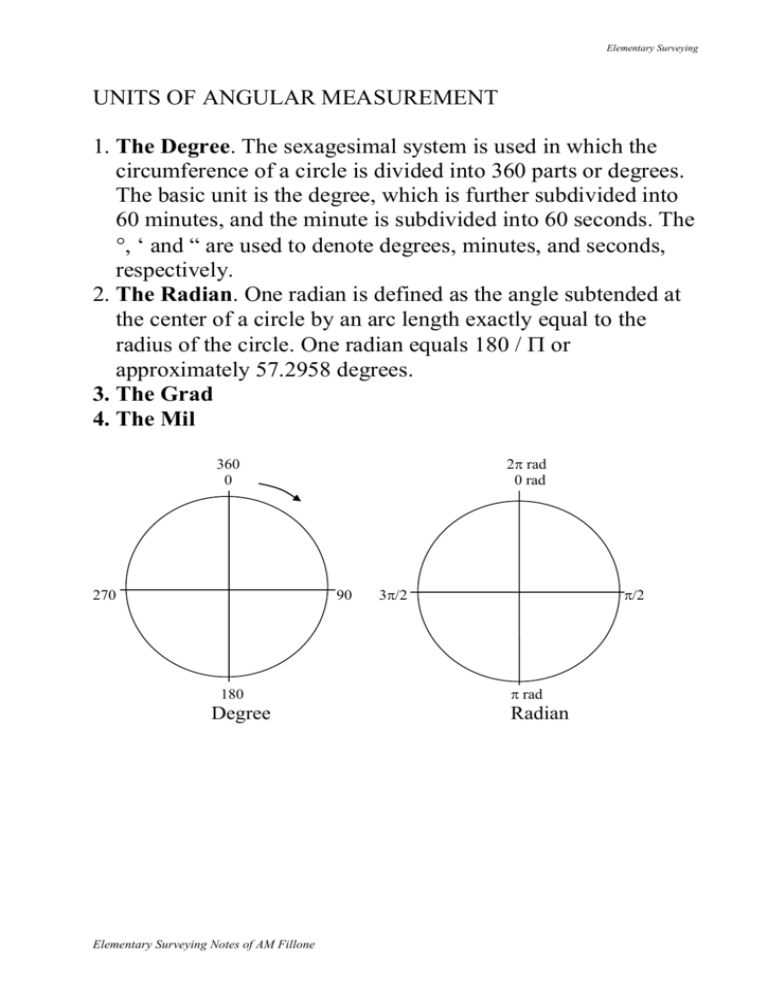
Elementary Surveying UNITS OF ANGULAR MEASUREMENT 1. The Degree. The sexagesimal system is used in which the circumference of a circle is divided into 360 parts or degrees. The basic unit is the degree, which is further subdivided into 60 minutes, and the minute is subdivided into 60 seconds. The , ‘ and “ are used to denote degrees, minutes, and seconds, respectively. 2. The Radian. One radian is defined as the angle subtended at the center of a circle by an arc length exactly equal to the radius of the circle. One radian equals 180 / or approximately 57.2958 degrees. 3. The Grad 4. The Mil 360 0 270 2 rad 0 rad 90 180 Degree Elementary Surveying Notes of AM Fillone /2 3/2 rad Radian Elementary Surveying DESIGNATION OF NORTH POINTS Map users are primarily concerned with the north point for the determination of directions. The following are the commonly used reference points; 1. True North – is the north point of the true meridian. In maps and sketches, it is portrayed in the direction of the actual location of the earth’s north geographic pole and is always shown along a vertical line. A star, an asterisk, or the letters TN symbolizes it. Figure 24-5a. 2. Magnetic North – a north point that is established by means of a magnetized compass needle when there are no local attractions affecting it. Magnetic north may be located either east or west of true north. A half arrowhead or the letters MN usually symbolizes the point. Figure 24-5b. 3. Grid North – a north point, which is established by lines on a map, which are parallel to a selected central meridian. It may coincide with lines directed toward true north. A full arrowhead or the letters GN or Y may symbolize grid north. Figure 24-5c. 4. Assumed North – is used to portray the location of any arbitrarily chosen north point. It may be symbolized by a small-blackened circle or the letters AN. Figure 24-5d. TN MN GN AN * W E W E W E W E S S S S (a) (b) (c) (d) Figure 24-5 Elementary Surveying Notes of AM Fillone Elementary Surveying DIRECTION OF LINES The direction of a line is defined as the horizontal angle the line makes with an established line of reference. There are various kinds of angles, which can be used to describe the direction of lines. In surveying practice, directions may be defined by means of, a) Interior angles, 1 5 2 4 3 b) Exterior angles, 1 A 5 B 2 E C 3 D 4 Elementary Surveying Notes of AM Fillone Elementary Surveying c) Deflection angles, B D 1 3 E 2 A C d) Angles to the right, B D A C e) Bearings, and f) Azimuths N a c 4430’ 50 W P E 2942’ b Bearing Pa = _________ Bearing Pb = _________ Bearing Pc = _________ Azimuth (from South) Pa = ________ Azimuth (from South) Pb = ________ S Azimuth (from North) Pc = ________ Note: Azimuths will be based either from the South or North going clockwise. Elementary Surveying Notes of AM Fillone Elementary Surveying FORWARD AND BACK AZIMUTHS - Any line established on the earth’s surface has two azimuths – a forward azimuth and a back azimuth. - These directions differ by 180 degrees from each other since the back azimuth is the exact reverse of the forward azimuth. - To determine the back azimuth when the forward azimuth is known, the following rules are used: Rule 1: If the forward azimuth of the line is greater than 180 degrees, subtract 180 degrees to obtain the back azimuth. Rule 2: When the forward azimuth of the line is less than 180 degrees, add 180 degrees to determine the back azimuth. - See Figure 25-10 and the Table as example below N N E 345 314 B Figure 25-10 50 N 165 N 230 D N 75 255 A C 134 LINE AB BC CD DE Obs. Azimuth from south Forward Back 23000’ 5000’ 31400’ 13400’ 25500’ 7500’ 16500’ 34500’ Elementary Surveying Notes of AM Fillone Calc. azimuth from north Forward Back 5000’ 23000’ 13400’ 31400’ 7500’ 25500’ 34500’ 16500’



